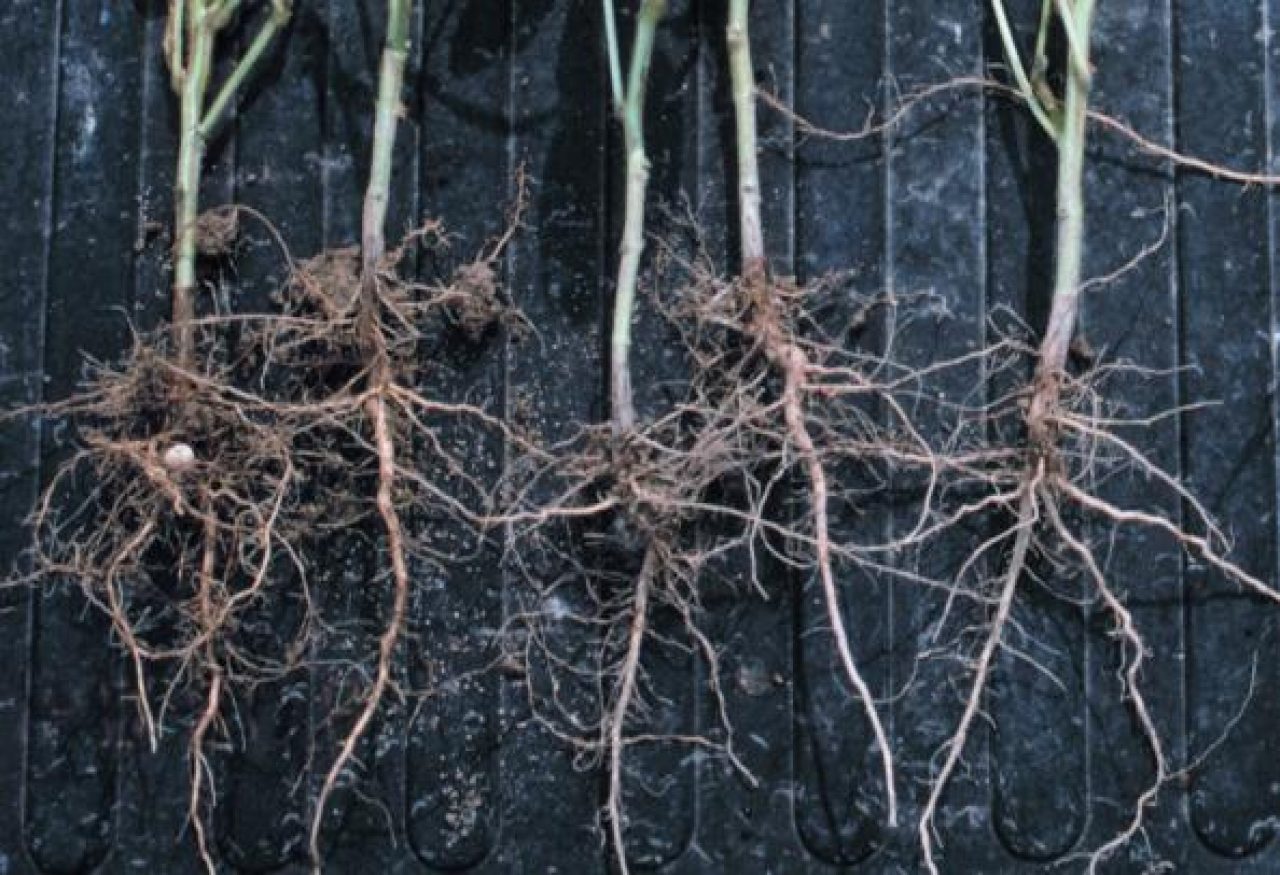Nitrogen-fixing bacteria (Bradyrhizobium japonicum) forms a symbiotic relationship with soybean roots, and results in the formation of nodules on the roots. These nodules can provide 50 to 75 percent of plant nitrogen (N) requirement.1 Since N is critical during pod development, scouting for nodule formation, function, and health can help provide the most benefit from this natural relationship. The health of a soybean crop is not determined by the number of nodules present on the roots. A crop can be healthy without proliferous nodulation. However, if the crop looks N deficient and poor nodulation is suspected, nodulation should be evaluated.
Proper Soybean Root Digging Technique
Carefully dig up 10 plants from each field and place in a bucket of water to remove soil from roots. Record sampling location, field conditions (soil moisture, ponding, etc.), plant growth stage, general plant health, and nodule numbers. Cut open nodules and record nodule colors. The reasons for different nodule numbers, sizes, and interiors are indicated below.
Low Nodule Number (less than 8 to 20)1

Causes
- Soil nitrogen levels are high.
- First time soybeans are being grown in a field.
Considerations
- Plant-available N in the field is suppressing nodulation.
- Rescue N should be applied, if needed, in accordance with needed, in accordance with local recommendations.
- Resample in one week to see if too early.
Small Nodule Size (smaller than 2 to 4 mm)1

Causes
- Immature, may or may not be fixing N.
- Could increase in size or small because of supplemental N.
- Can be specific to strain of bacteria.
Considerations
- Resample in one week.
- In a supportive environment, number and size should increase until the R5 growth stage.2
Empty Cases of Nodules

Causes
Feeding from soybean nodule fly or bean leaf beetle larvae.
Considerations
- Seed treatments for bean leaf beetle may help protect early nodulation.
Nodules with White Interiors

Causes
- Immature, and have not begun fixing N.
Considerations
- Resample in one week.
- Nodules continue to develop until the R5 stage.
Black or Brown Nodule Interior
Causes
Inactive, rotted or dead.
Considerations
- Flooded fields after nodules formed.
- Soils saturated for 3 days.3

Causes
Inactive, lack of leghemoglobin (pink protein).
Considerations
Leghemoglobin levels drop after early pod development stage, and nodule greening indicates physiological maturity.4
May also indicate saprophytic nodules.
Not to be Confused With:
Soybean cyst nematode (SCN) cysts will be smaller (size of a pinhead), lemon-shaped, and change in color from white to yellow, then to tan or brown. There may be fewer nitrogen fixing nodules with a SCN infested crop.5 Above-ground symptoms of SCN may be similar to nitrogen deficiency but may appear related to equipment entry and operations in a field.
Below-ground scouting in soybeans is beneficial especially in fields displaying lighter green foliage. Examining the interior colors of nodules indicates their ability to fix N and be the liaison between fertility and pods full of soybeans.
Sources:
1Staton, M. 2011. Evaluating soybean nodulation. Michigan State University Extension.
22012. Successful soybean nodulation without rhizobia. Ag Professional. https://www.agprofessional.com/article/successful-soybean-nodulation-without-rhizobia.
3Staton, M. 2014. Identifying and responding to soybean inoculation failures. No-Till Farmer. https://www.no-tillfarmer.com/articles/2418-news---identifying-and-responding-to-soybean-inoculation-failures.
4Pfeiffer, N.E., Torres, C.M., and Wagner, F.W. 1982. Proteolytic activity in soybean root nodules. Plant Physiology. Vol. 71. Pages 797-802.
5Tylka, G. 1994. Soybean cyst nematode. Iowa State University. https://nematode.unl.edu/scn/scnisu.htm.
Conley, S.P. 2016. Non-nodulating soybeans? Farms.com.
5002_S1
